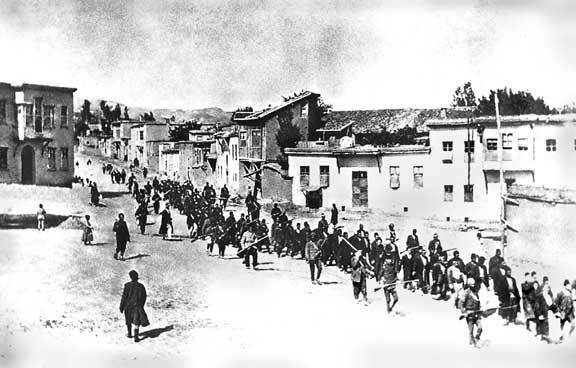Centenary of the Ottoman campaign to destroy its Armenian population
Today, 24 April 2015, marks the centenary of the deportation of Armenian intellectuals from Constantinople (Istanbul), recognised as the start of the Ottoman Empire’s campaign to destroy its Armenian population.

This day saw the arrest of 235 leading members of Constantinople’s Armenian community – among them poets, doctors, religious leaders and political dissidents representing some of the most prominent Armenian intellectuals in the Ottoman Empire. Many of the 235 would be tortured and publicly executed in the months following their arrest.
Armenians within the Ottoman Empire were already in a precarious position when the First World War broke out in 1914. Major pogroms during 1894-96, and again in 1909, had seen thousands massacred.
After a number of military setbacks in the First World War, Ottoman leaders undertook measures to deport Armenian populations from their homes despite the vast majority not being located in areas of military activity.
The Armenians were deported along a number of routes to desert areas that could not support them. When the Armenian community of Van, a town in the southeast of Turkey, resisted attacks against them on 20 April 1915, Ottoman leaders decided to make deportations an empire-wide policy. The Armenians forced to undertake these death marches were deprived of food and water. Rape and murder were routinely committed.
Satenig Ehranjian was an Armenian deported with her family from Erzurum in eastern Turkey in June 1915. The authorities had already taken her fiancé when she was forced from her home. After several days walking towards the desert, she was separated from her mother and sister. Her mother was too ill to continue on the torturous journey and her sister was abducted. Satenig never saw her fiancé, mother or sister ever again.
Deportations like this occurred across the Ottoman Empire throughout 1915 and 1916. By the end of the First World War, Ottoman policies of expulsion and extermination had resulted in the deaths of an estimated 1.5 million Armenian men, women and children.
The Ottoman Empire targeted other minority groups during this period, including Assyrians and ethnic Greeks.
In 1933, the Polish Jewish lawyer Raphael Lemkin, was so motivated by the lack of recognition and awareness of the crimes in Armenia which occurred only a few years before, that he presented a paper to the League of Nations. His ideas were first presented to his European legal colleagues in Madrid in 1933 as an essay entitled Crime of Barbarity. He defined barbarity as the ‘premeditated destruction of national, racial, religious and social collectivities’, based upon the events in Armenia, and insisted this must be illegal in international law. Among the isolationist climate of interwar Europe, these ideas fell on deaf ears.
Adolf Hitler is reported to have referenced the systematic destruction of the Armenians as he planned the Nazi invasion of Poland in August 1939:
‘I put ready my Death’s Head units, with the order to kill without pity or mercy all men, women, and children of the Polish race or language. Only thus will we gain the living space that we need. Who still talks nowadays of the extermination of the Armenians?’
Raphael Lemkin managed to escape Nazi-occupied Poland, but the majority of his family were slaughtered in the Holocaust. This added an intensely personal motivation to his campaign. He realised his campaign was missing something: a label for this most barbarous of crimes that captured its inherent brutality and unique, destructive nature. Lemkin coined the word ‘genocide’.
In 1946 the UN recognised the term ‘genocide’ and affirmed the cause to which Lemkin had dedicated his life. To date, the 1946 convention is still used to recognise the actions of a state-sponsored attempt to destroy a particular group of its people.
Holocaust Memorial Day (HMD) was set up to commemorate the Holocaust, and ensure that the Holocaust’s uniqueness – its scale, its industrialised nature, and its attempt at total destruction – continues to be recognised. HMD also provided us with an opportunity to reflect on the fact that the lessons of the Holocaust have not been learned, as genocide has been committed again, in Cambodia, Rwanda, Bosnia and Darfur.
Whilst HMD does not explicitly commemorate the crimes against the Armenians on 27 January, HMDT does make reference to the persecution of the Armenians on the HMDT website because of the importance of these events to the development of the concept of genocide. We highlight the stories of Armenian survivors Satenig Ehranjian and Astrid Aghajanian.
Today we join people around the world to mark 100 years since the start of the Ottoman Empire’s campaign to destroy its Armenian population.
Recognition of the crimes as ‘genocide’
There is a continuing campaign to encourage governments and individuals to recognise these crimes as ‘genocide’.
As genocide is a crime with a particular definition, the Holocaust Memorial Day Trust does not have the legal, political or academic authority to make judgments about genocide recognition. We follow the lead of international criminal tribunals which have indicted suspects for the crime of genocide. These tribunals have only taken place since the UN recognised genocide as a crime in 1946.
This is in line with the policy of the UK Government, which has only formally recognised genocide as having taken place when international criminal tribunals have found suspects guilty of the crime of genocide, namely in Rwanda in 1994, and Srebrenica (Bosnia) in 1995.